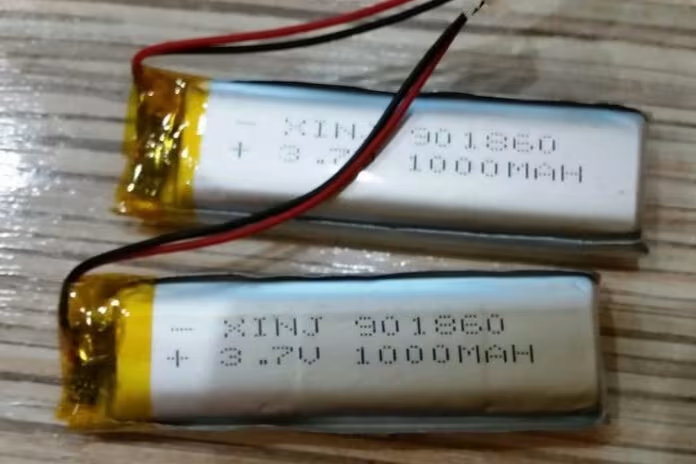- The $280 Metal Detector Repair Bill That Taught Me Everything About Detector Care
- Why Metal Detector Seasonal Maintenance and Winter Preparation Matter
- Your Metal Detector Maintenance Toolkit: Essential Equipment for Detector Care
- How to Maintain Metal Detector Equipment: Critical Maintenance Tasks Step-by-Step
- Best Way to Store Metal Detector
- Preventive Detector Care
- The Bottom Line on Equipment Maintenance
- References
The $280 Metal Detector Repair Bill That Taught Me Everything About Detector Care
Last spring, I pulled my Garrett AT Pro out of the garage after winter, popped in batteries, flipped the switch, and… nothing. When I finally got the battery compartment open, I found a white crystalline nightmare. Battery acid had leaked everywhere, corroding the contacts and creeping up the wiring. The metal detector repair estimate? $280. Because I’d ignored basic equipment maintenance and left batteries in over winter.
That expensive lesson taught me something: metal detector care isn’t optional. The kicker? I could have prevented it with two hours of work following a proper metal detector maintenance guide and maybe $40 in supplies.
Whether you’re storing metal detector equipment like a Minelab Equinox, Nokta Simplex, or Fisher F75, this guide covers everything about how to winterize metal detector gear and protect your investment.
Why Metal Detector Seasonal Maintenance and Winter Preparation Matter
Three silent killers threaten metal detecting gear during winter storage: battery corrosion, moisture damage, and connection degradation. These aren’t theoretical – they’re the top causes of post-winter failures costing $150-500 in metal detector repair expenses.
Here’s what happens without proper detector storage: Temperature swings create condensation on circuit boards. Those batteries leak potassium hydroxide – a caustic substance eating through contacts and wires. Meanwhile, dirt trapped in cam locks acts like sandpaper, wearing down components with every temperature cycle.
The physics is simple: cold air holds less moisture than warm air. When your frozen detector warms up, water vapor condenses on the coldest surfaces first – precisely where you don’t want it. Research shows improper detector storage reduces equipment lifespan by 30-50%.
Manufacturer warranty data from Garrett, Minelab, and Fisher shows neglect-related damage accounts for more warranty denials than all other causes combined. Those warranties explicitly exclude “neglect” – meaning if you skip metal detector care and maintenance, you’re on your own.
The economic argument for detector upkeep: Spend 2-3 hours and $30-50 on prevention with this metal detector maintenance checklist, or pay $150-500 for repairs.
Your Metal Detector Maintenance Toolkit: Essential Equipment for Detector Care
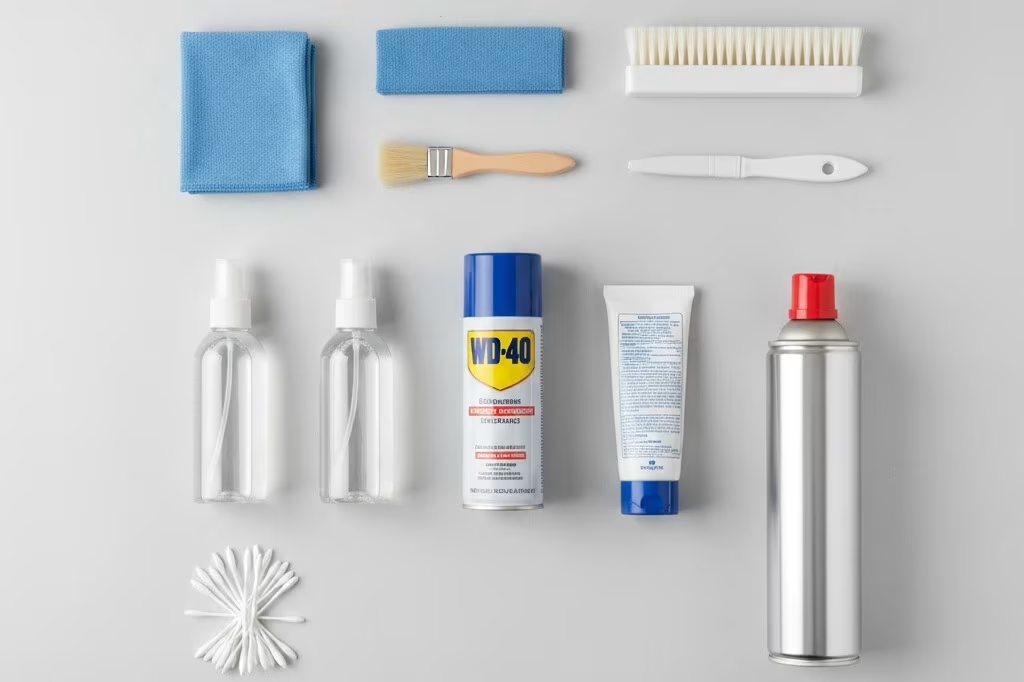
Before diving into how to maintain metal detector equipment, assemble your toolkit:
Cleaning Supplies for Detector Cleaning:
- Microfiber cloths
- Soft-bristled brush for cleaning metal detector coil surfaces
- Mild dish soap
- Isopropyl alcohol (70%+)
- White vinegar (for battery corrosion during metal detector battery maintenance)
- Compressed air
Protection & Lubrication for Detector Winterization:
- Silicone-based lubricant for O-rings (NEVER petroleum jelly – it destroys rubber)
- WD-40 for connectors
- Light silicone spray for metal shafts
Storage Materials for Protecting Metal Detector in Winter:
- Silica gel desiccant packets (2-3 packets)
- Padded storage case
- Battery storage containers
Total investment? About $30-50 versus my $280 metal detector repair bill.
How to Maintain Metal Detector Equipment: Critical Maintenance Tasks Step-by-Step
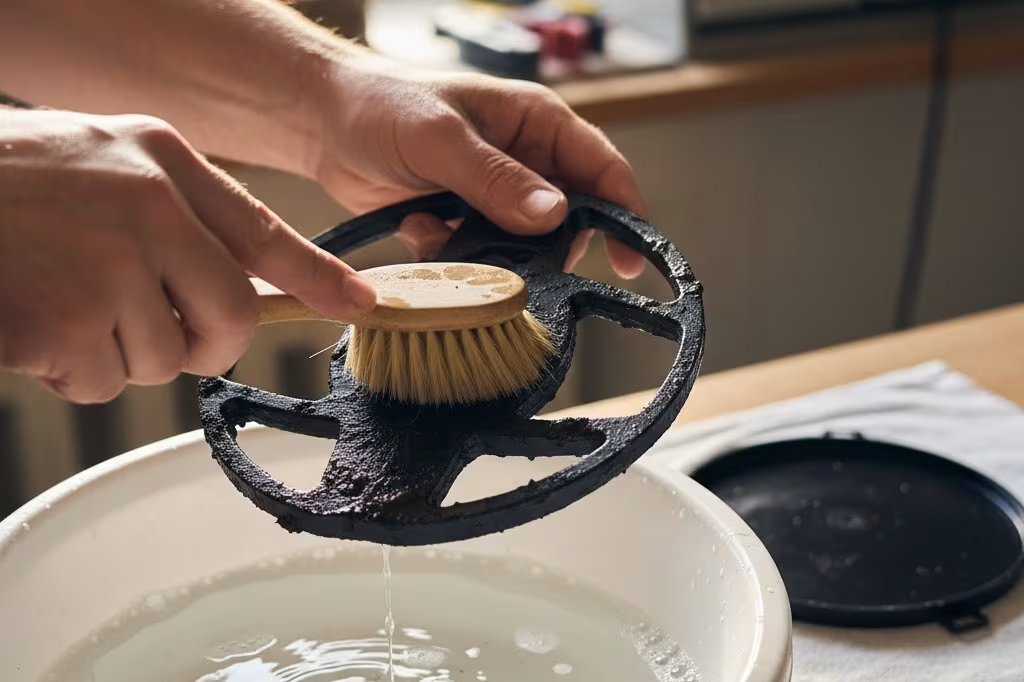
Task A: How to Clean Metal Detector – Deep Detector Cleaning from Coil to Control Box
Start with cleaning metal detector coil components. Remove the coil cover completely – metal detecting forums report hidden debris between cover and coil causes mysterious falsing. Wash the coil with mild soap and a soft brush. For waterproof coils, rinse with lukewarm water (hold upside down at the connection). Saltwater hunters: immediate freshwater rinsing is mandatory for proper metal detector off-season care.
For how to clean metal detector shaft and hardware: Extend telescoping sections fully, use compressed air on cam locks, wipe down with a damp cloth, and check all mounting hardware.
Control box cleaning requires care. Remove batteries first – non-negotiable. Most control boxes aren’t waterproof despite waterproof coils. Use a barely-damp microfiber cloth. For the LCD screen, dry cloth only.
Clean coil connectors using Minelab’s technique for detector cleaning and storage: hold connector upside down, spray WD-40 inside using the thin straw, letting spray force flush out dirt. Wipe excess immediately.
Task B: Metal Detector Battery Maintenance (Most Critical Step)
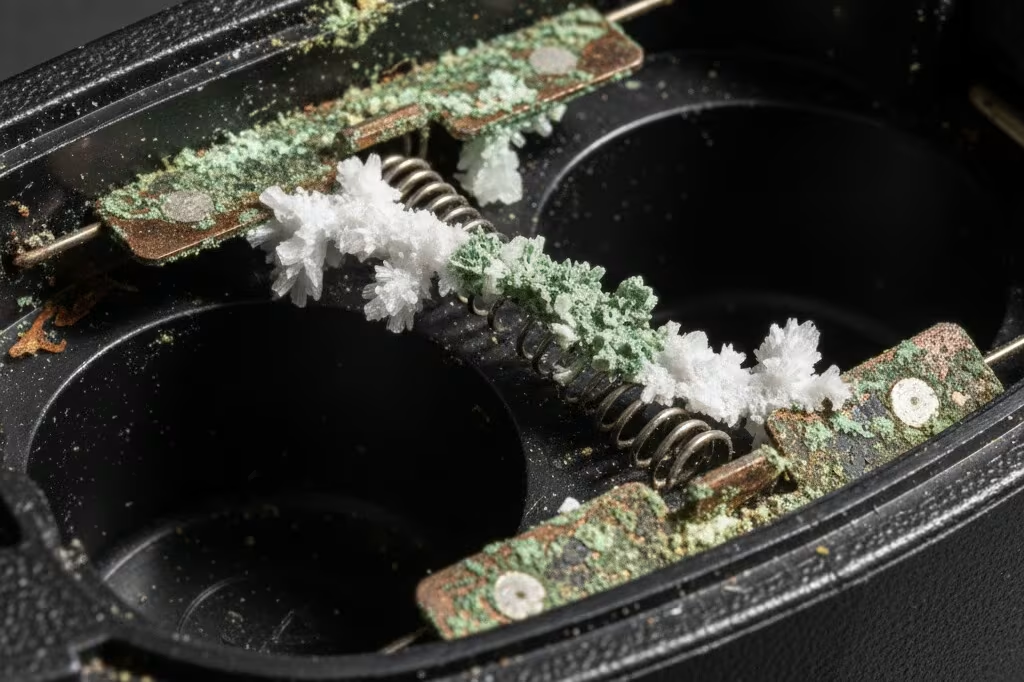
Here’s the rule saving hundreds in metal detector repair costs: Remove ALL batteries for storage exceeding two weeks.
As one TreasureNet forum user says about the best way to store metal detector equipment: “No longer than two weeks at idle. Won’t risk battery leakage. I’ve seen too many detectors damaged by corroded battery compartments.”
Alkaline Batteries: Remove immediately for storage over 2 weeks when you prepare metal detector for winter. Store at 32-80°F in original packaging. Inspect monthly for leakage. For existing corrosion during metal detector battery maintenance: apply white vinegar to contacts, wait 5-10 minutes, scrub with toothbrush, neutralize with baking soda, then clean with alcohol.
Lithium-Ion Batteries (XP Deus 2, Nokta Makro Legend, Minelab Equinox): Store at 40-70% charge for periods exceeding one month. Fully charged batteries undergo stress accelerating capacity loss. Completely dead batteries suffer permanent damage.
Practical approach: Fully charge, then use detector for about half its normal runtime before storage. Store at 32-77°F.
Critical warning for detector winterization: Never charge lithium-ion batteries below 32°F – charging when cold causes lithium plating permanently damaging cells. Check charge every 3-6 months during extended detector storage.
NiMH Batteries: Store fully charged at 25°C ± 3°C, with recharge annually if stored beyond 12 months.
Task C: O-Ring Maintenance for Waterproof Metal Detecting Gear
O-ring failure transforms waterproof detectors into paperweights requiring costly metal detector repair. Inspect O-rings during detector cleaning sessions for cracks, flattening, hardening, or deterioration. Replace immediately if damaged – replacement costs $2-10 versus $150+ water damage repairs.
Lubrication for protecting metal detector in winter:
- Remove O-rings (if accessible)
- Clean with mild soap and water
- Rinse and dry completely
- Apply silicone-based lubricant sparingly
- Wipe excess
- Reinstall without twisting
Remember: ONLY silicone-based lubricants. Petroleum jelly destroys O-rings.
Best Way to Store Metal Detector
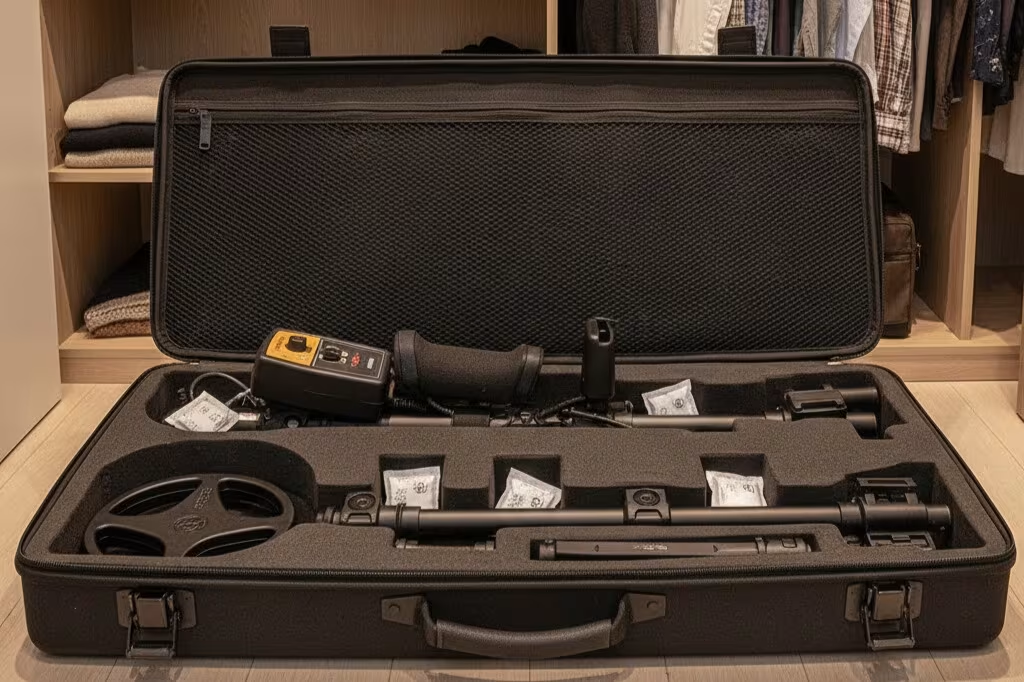
Temperature-controlled indoor storage prevents 95% of winter damage. Ideal detector storage locations: spare room closets, bedrooms, or temperature-controlled basements at 50-77°F with 35-65% humidity.
Avoid when you prepare metal detector for winter: unheated garages (temperature swings from -15°F to 80°F), outdoor sheds, vehicle trunks, and attics.
Winter Metal Detector Storage Tips for 3+ months:
- Complete detector cleaning (24-hour drying if wet)
- Remove ALL batteries (critical metal detector battery maintenance)
- Lubricate O-rings on waterproof models
- Clean and spray connectors with WD-40
- Apply silicone spray to metal shafts
- Add 2-3 silica gel packets to storage case
- Store in climate-controlled location
Wall-mounted storage (guitar hangers $15-30, tool holders $10-25) works great for shorter breaks between metal detecting sessions.
Preventive Detector Care
The best metal detector seasonal maintenance starts with good habits:
After Every Metal Detecting Session: Five-minute wipe-down prevents hardened residue. Quick detector cleaning saves hours when you store metal detector for winter.
Use Protective Covers: Coil covers ($15-35) and control box covers ($10-25) are cheap insurance for metal detecting gear.
Monthly Detector Upkeep: Check battery contacts, cables, and adjustment mechanisms. Catch problems before field failures.
Stay Current: Check manufacturer websites for firmware updates twice yearly.
The Bottom Line on Equipment Maintenance
That $280 metal detector repair bill taught me: proper equipment maintenance isn’t a chore – it’s an investment. Two hours and $40 versus hundreds in repairs? Easy decision.
Metal detector battery maintenance is your #1 priority when you prepare metal detector for winter. Temperature-controlled detector storage is #2. Everything in this metal detector maintenance guide builds from there.
Follow these metal detector winter preparation steps, and your detector emerges ready to find treasure. Skip the detector winterization process, and you’re shopping for a new machine.
Start your metal detector off-season care checklist today using these winter metal detector storage tips. Your spring metal detecting season depends on proper detector cleaning and storage now.
Now get your metal detecting gear safely stored – and I’ll see you in the fields come spring! 🔍
References
- “Your Off-Season Overhaul: Complete Metal Detector Winter Maintenance Guide,” https://www.treasurenet.com/threads/storing-batteries-in-metal-detectors-long-term.429035/
- Minelab Support Downloads and Product Manuals, https://www.minelab.com/support/downloads/product-manuals-guides
- Garrett AT Pro Metal Detector Manual, https://garrett.com/sites/default/files/2019-11/1533300_atpro_int_english.pdf
- “Detector Maintenance,” Friendly Metal Detecting Forum, https://metaldetectingforum.com/index.php?threads/detector-maintenance.258502/
- “How to Perform Metal Detector Maintenance,” Treasure Coast Metal Detectors, https://treasurecoastmetaldetectors.com/blogs/news-1/how-to-perform-metal-detector-maintenance
- “Safe to lubricate o-rings with petroleum jelly?” Candlepower Forums, https://www.candlepowerforums.com/threads/safe-to-lubricate-o-rings-with-petroleum-jelly.54243/
- “What should I use as a lubricant for my o-rings and gaskets?” Hayward Pool Equipment, https://hayward.com/knowledge-base/what-should-i-use-as-a-lubricant-for-my-o-rings-and-gaskets/
- “How do I prep my Lithium battery for off-season storage?” RELiON Battery, https://www.relionbattery.com/knowledge/how-do-i-prep-my-lithium-battery-for-off-season-storage
- “Tips for Storing Your Lithium Batteries in the Winter,” Patriot Power Source, https://patriotpowersource.com/blogs/lithium-golf-cart-batteries/tips-for-storing-your-lithium-batteries-in-the-winter
- “How should I store my lithium batteries for the winter?” Black+Decker Support, https://support.blackanddecker.com/hc/en-us/articles/360012617737-How-should-I-store-my-Black-and-Decker-lithium-batteries-for-the-winter

My name is Paul and I am the founder of Detector For Metal, a dedicated resource for metal detecting enthusiasts seeking to uncover historical treasures and connect with the past using the latest technology. As a stay-at-home dad and family man, I’ve found metal detecting to be the perfect hobby that combines family adventure with historical learnings for the whole family.
As a father, I’m deeply committed to passing on this hobby to the next generation of detectorists, starting with my own children. I share advice on everything from metal detecting with kids to exploring the top 10 metal detecting sites you never thought about. My methodical approach to the hobby goes beyond the thrill of discovery—it’s about creating family traditions while preserving history and sharing the stories of those who came before us.

